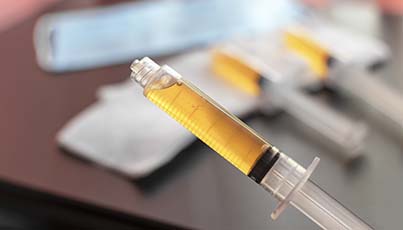The human body comes fully equipped with the incredible ability for self-repair and restoration. It’s an amazing innate function that works to naturally restore and repair the body from damage, injury or illness. The majority of the time, that natural therapeutic ability is all we need to restore function and maintain optimal health. As efficient as the body is at patching itself up, there are times when it is overmatched by and injury or illness and needs a boost.
Orthobiologics represent an innovative group of cellular based non-surgical therapies that naturally reduce inflammation and promote a faster, more robust healing of damaged tissue. At their core is the utilization of the body’s powerful natural ability to naturally heal and renew itself. Through orthobiologics, physicians now have the means to harness and intensify that natural healing power and apply it in high concentration to stimulate advanced healing, reduce pain and improve function.
Platelet-Rich Plasma Therapy (PRP)
Platelet-rich Plasma Therapy or PRP, is an advanced orthobiologic treatment option that uses the patient’s own blood components to stimulate the body’s natural healing process in the damaged or injured area causing pain. The therapy centers around drastically enhancing the concentration of platelets found circulating in our blood stream to boost the natural biological healing powers of the body. It is a treatment option that indicated for injuries or damage to tendons, ligaments, muscles and joints.

How does PRP work?
To begin, a physician will take a small amount of blood from the patient’s arm. That blood is then placed in specially designed centrifuge where it is spun down to isolate and increase the concentration of platelets. The result is a super concentrated serum of platelets that is then injected under guided x-ray into the affected or injured area of the body. Once the super concentrated platelets hit the damaged area being treated, they release a powerful dose of growth factors. These growth factors are natural occurring compounds that trigger your body’s ability to repair and renew itself. The entire PRP production process usually takes around one hour and should only be conducted by a licensed physician.
What conditions does PRP treat?
Platelet-rich plasma therapy is commonly used for acute and chronic conditions such as:
- Tendinopathy
- Rotator Cuff Tendinitis
- Tennis Elbow
- Plantar Fasciitis
- Ligament sprains or tears (MCL, LCL, ACL)
- Annular Disc Tears
- Achilles Tendon Injuries
- Knee Osteoarthritis
- Meniscus Tears
- Arthritis Pain
What can I expect after a PRP Treatment?
The goal behind platelet rich plasma to evoke long term healing. Patients will notice a gradual improvement of their symptoms over the course of the first few weeks immediately following treatment. In most cases, patients experience a significant increase in both function and pain reduction after four to six weeks as the healing process continues. In some cases, depending on the extent of the injury treated, additional PRP treatments might be necessary to ensure the maximum benefit. The results are usually long term, often providing permanent repair to the damaged tissue.
Are their risks associated with this treatment?
Since platelet rich plasma therapy utilizes your body’s own natural properties to treat your injury, complications and negative side effects from a platelet rich plasma treatment are very uncommon. PRP is a type of treatment that seeks to optimize the body’s initial inflammatory response to damage, it is essential that all anti-inflammatory medications be halted prior to the use of PRP.
How do I know if I Am a candidate for treatment?
Platelet rich plasma is indicated for those patients who have been experiencing chronic pain for more than six months and have not experienced relief with traditional pain management treatment options. If you believe you might be a candidate for PRP, please speak with your physician regarding the possibility that PRP might be right for you. Your TCPC physician will perform an onsite physical examination and thorough review of your medical records to determine if this therapy will benefit you.
Is PRP covered by my insurance?
Currently, platelet rich plasma is considered experimental by most insurance companies and therefore are not currently covered by insurance. If you have any questions regarding your coverage, please contact your insurance carrier for details.
